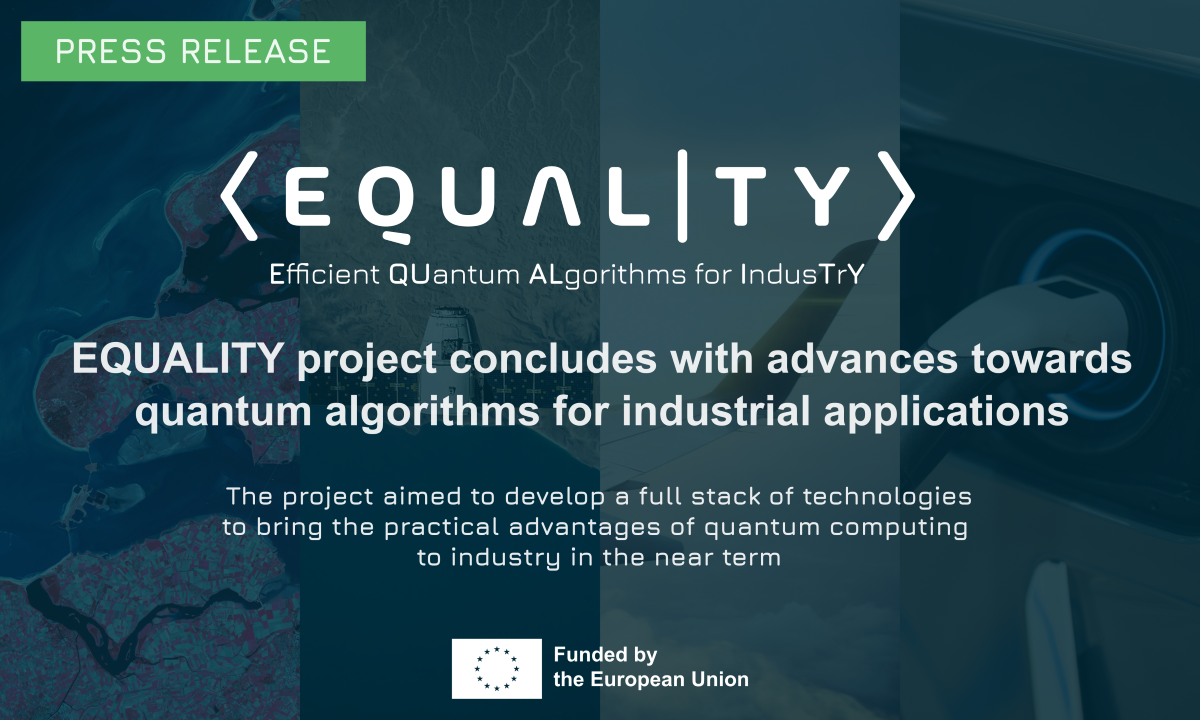Horizon Europe’s EQUALITY project concludes with advances towards quantum algorithms for industrial applications
The project aimed to develop a full stack of technologies to bring the practical advantages of quantum computing to industry in the near term
TOURS, FRANCE, October 15, 2025 /EINPresswire.com/ -- Quantum computing is one of the frontiers of research and innovation due to its potential to outperform classical computers in specific tasks. The EQUALITY (Efficient QUantum ALgorithms for IndusTrY) project, funded by the European Union under the Horizon Europe programme, had the mission of developing innovative quantum computing algorithms to solve strategic industrial problems while dealing with the limitations of this nascent technology.The consortium, comprising Airbus, Capgemini, Da Vinci Labs, Fraunhofer ENAS, the German Aerospace Center, INRIA, and Leiden University, targeted industrial use cases where quantum computing is expected to have the greatest impact. These include fluid dynamics computations for aerospace applications, the design of batteries and fuel cells, and space mission optimisation and data analysis. Each of these tasks, routinely faced by the industrial partners, is highly demanding in terms of computational resources, forcing engineers to either use simplistic models or rely on costly build-and-test cycles.
The opportunity offered by quantum computers to tackle such challenges promises a competitive edge for the European industry. Hence, the project aimed to develop a full stack of technologies comprising core quantum algorithms and hardware, as well as a set of enabling technologies (middleware and APIs, efficient resource utilisation strategies, etc.) to make the most of Noisy Intermediate-Scale Quantum hardware.
Between 2022 and 2025, the consortium developed novel quantum approaches to representing and optimising quantum circuits with regard to hardware limitations, the analysis of noise in quantum bits, and its impact on applied computations and tailoring of quantum circuits. Project partners also achieved notable scientific advances aimed at the efficient utilisation of quantum resources, which is crucial in the context of near-term quantum computing applications. Among them are efficient methods for circuit cutting and estimation of quantum noise with blind quantum computation, hardware-oriented compilation of quantum circuits, and analog approaches for solving partial differential equations.
EQUALITY partners succeeded in describing the partial differential equations of typical battery and fuel cell models, with their non-linear and complex behaviour, using differentiable quantum circuit algorithms, while also generating benchmark results for future quantum chemistry simulations. The consortium also explored how aerodynamic simulations could benefit from the use of quantum algorithms to solve partial differential equations for computational fluid dynamics. The project identified a promising use case for quantum machine learning on synthetic aperture radar satellite data, where the class of parameterised quantum circuits studied is natively aligned with certain preprocessing steps on raw images, enabling pattern recognition directly on raw datasets with only partial classical processing. On the other hand, the consortium developed a better classical algorithm than previous approaches for satellite mission optimisation, showing that quantum computing may not be suitable in all cases, but questioning its utility in practice can nevertheless yield beneficial advances.
With these achievements, EQUALITY helped to strengthen the links between strategic European industries and the emerging quantum ecosystem while contributing to technologies critical to the green transition.
Learn more about the EQUALITY project and its achievements at https://equality-quantum.eu/.
Renan Picoreti Nakahara
Da Vinci Labs, on behalf of the EQUALITY consortium
email us here
Visit us on social media:
LinkedIn
Legal Disclaimer:
EIN Presswire provides this news content "as is" without warranty of any kind. We do not accept any responsibility or liability for the accuracy, content, images, videos, licenses, completeness, legality, or reliability of the information contained in this article. If you have any complaints or copyright issues related to this article, kindly contact the author above.
